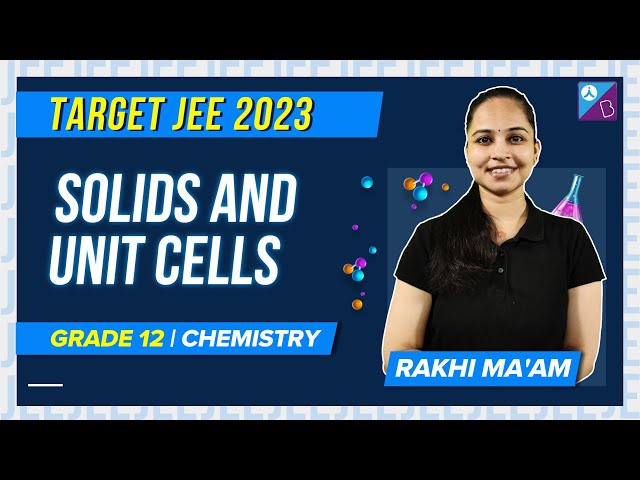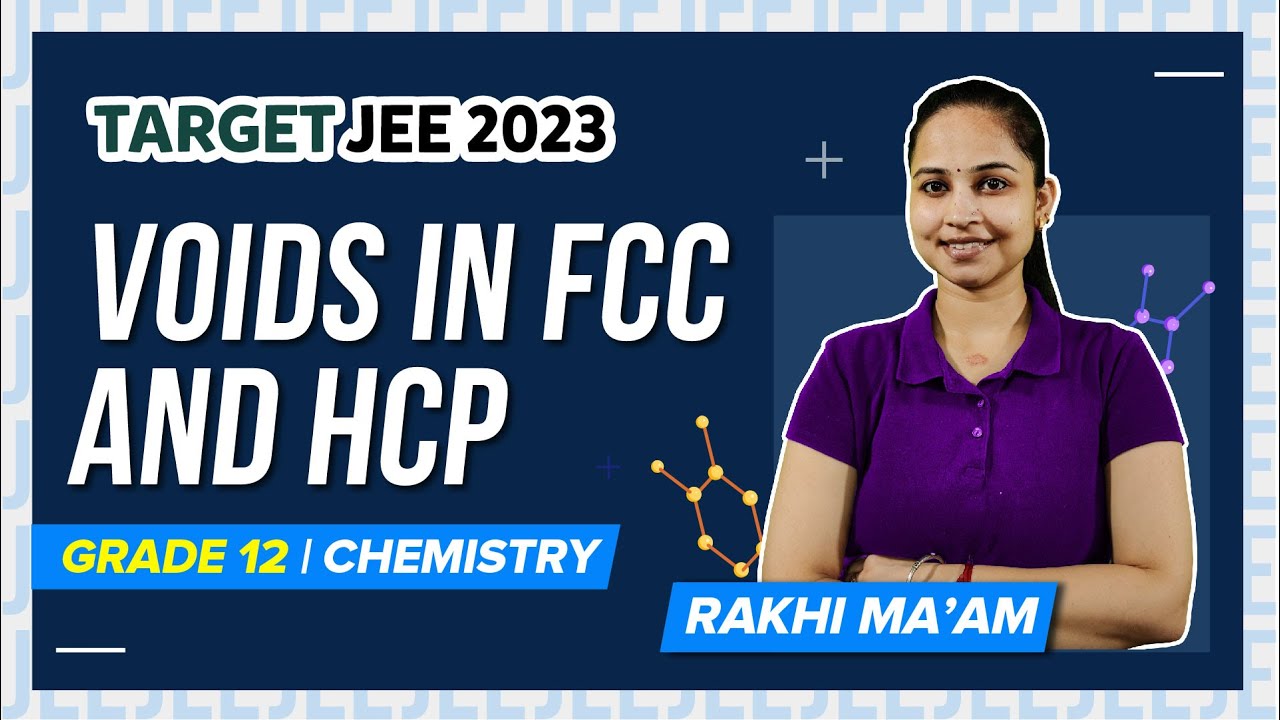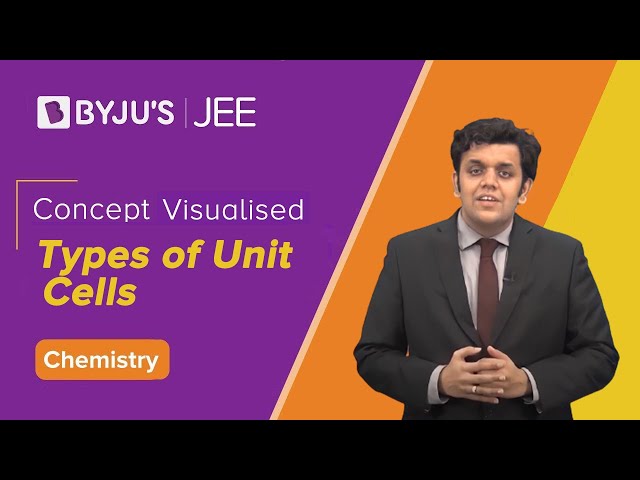Solid State JEE Main Previous Year Questions with Solutions are given here. Solid state is one of the states of matter. Matter exists in three states – solid, liquid and gas. This topic deals with the concept of solid-state in a broader aspect and explains all the underlying terms including the properties as well as the types of solids.
Solids generally exhibit some characteristics that make them different from liquids and gases. For example, they have the ability to resist any force that is applied to its surface. As far as JEE exam is concerned, this topic is very important. Practising these questions will help students to get an idea of the question pattern. Students can expect 2 questions from this topic. BYJU’S provides accurate solutions prepared by our subject matter experts. Students can easily download these solutions in PDF format for free.
Download Solid State Previous Year Solved Questions PDF
JEE Main Previous Year Solved Questions on Solid State
1. Sodium metal crystallizes in a body centred cubic lattice with a unit cell edge of 4.29 Å. The radius of sodium atom is approximately
(a) 5.72 Å
(b) 0.93 Å
(c) 1.86 Å
(d) 3.22 Å
Solution:
For bcc, r = (√3/4)a
a = 4.29
r = (√3/4)×4.29
= 1.86
Hence option (3) is the answer.
2. Which type of ‘defect’ has the presence of cations in the interstitial sites?
(1) Vacancy defect
(2) Frenkel defect
(3) Metal deficiency defect
(4) Schottky defect
Solution:
The Frenkel defect is formed when an atom or smaller ion (usually cation) leaves its place in the lattice, creating a vacancy, and becomes an interstitial by lodging in a nearby location.
Hence option (2) is the answer.
3. An element having an atomic radius of 0.14 nm crystallizes in an fcc unit cell. What is the length of a side of the cell?
(1) 0.96 nm
(2) 0.4 nm
(3) 0.24 nm
(4) 0.56 nm
Solution:
For fcc unit cell, √2a = 4r
r = 0.14 nm
√2a = 4×0.14
a = 4×0.14/√2 = 0.396 ≈ 0.4 nm
Hence option (2) is the answer.
4. The edge length of a face centered cubic cell of an ionic substance is 508 pm. If the radius of the cation is 110 pm, the radius of the anion is :-
(1) 144 pm
(2) 288 pm
(3) 398 pm
(4) 618 pm
Solution:
Given a = 508
Radius of cation, r = 110
a = 2(r+ + r–)
508 = 2(110+ r–)
2r– = 508- 220
r– = 144 pm
Hence option (1) is the answer.
5. Lithium forms body centred cubic structure. The length of the side of its unit cell is 351 pm. Atomic radius of the lithium will be:-
(1) 152 pm
(2) 75 pm
(3) 300 pm
(4) 240 pm
Solution:
For Body centred cubic structure, radius (r ) = √3a/4
Here edge length of unit cell, a = 351
So r = √3×351/4 = 151.98 ≈ 152 pm
Hence option (1) is the answer.
6. Copper crystallises in fcc lattice with a unit cell edge of 361 pm. The radius of copper atom is:-
(1) 181 pm
(2) 108 pm
(3) 128 pm
(4) 157 pm
Solution:
For Face centred cubic structure, radius (r ) = a/2√2
Here edge length of unit cell, a = 361 pm
So r = 361/2√2 = 128 pm
Hence option (3) is the answer.
7.The radius of a calcium ion is 94 pm and of the oxide ion is 146 pm. The possible crystal structure of calcium oxide will be:-
(1) Octahedral
(2) Tetrahedral
(3) Pyramidal
(4) Trigonal
Solution:
Radius ratio = radius of cation / radius of anion
r+/r– = 94/146 = 0.643
The radius ratio lies in between 0.414 – 0.732 .
So the coordination number of calcium is 6.
The possible crystal structure of calcium oxide will be octahedral.
Hence option (1) is the answer.
8. In a face centred cubic lattice, atom A occupies the corner positions and atom B occupies the face centre positions. If one atom of B is missing from one of the face centred points, the formula of the compound is :-
(1) A2B3
( 2) A2B5
(3) A2B
(4) AB2
Solution:
No. of atom A per unit cell = 8×1/8 = 1
No. of atom B per unit cell = 5×1/2 = 2.5
So AB2.5 or A2B5
Hence option (2) is the answer.
9. Ammonium chloride crystallizes in a body centred cubic lattice with edge length of unit cell of 390 pm. If the size of chloride ion is 180 pm, the size of ammonium ion would be:
(1) 158 pm
(2) 174 pm
(3) 142 pm
(4) 126 pm
Solution:
Given edge length of unit cell, a = 390 pm
Size of chloride ion, r– = 180 pm
√3a/2 = r+ + r–
√3×390/2 = 180 + r–
So r– = 337.75 – 180
= 157.75 pm ≈ 158 pm
Hence option (1) is the answer.
10. Experimentally it was found that a metal oxide has formula M0.98O. Metal M, is present as M2+ and M3+ in its oxide. Fraction of the metal which exists as M3+ would be :-
(1) 7.01%
(2) 4.08%
(3) 6.05%
(4) 5.08
Solution:
Oxidation state of oxygen = -2
For M0.98O to be neutral, total oxidation state of M0.98 = +2
Let the fraction of M3+ be x.
The fraction of M2+ will be (0.98-x)
For the compound to be neutral,
3x+2(0.98-x) = 2
3x+1.96 – 2x = 2
x = 2-1.96 = 0.04
Fraction of the metal which exists as M3+ would be = 0.04×100/0.98 = 4.08 %
Hence option (2) is the answer.
11. In a monoclinic unit cell, the relation of sides and angles are respectively
(1) a ≠ b ≠ c and α ≠ β ≠ γ ≠ 900
(2) a ≠ b ≠ c and β = γ = 900 ≠ α
(3) a = b ≠ c and α = β = γ = 900
(4) a ≠ b ≠ c and α = β = γ = 900
Solution:
For a monoclinic unit cell, a ≠ b ≠ c and β = γ = 900 ≠ α
Hence option (2) is the answer.
12. CsCl crystallises in body centred cubic lattice. if ‘a’ is its edge length then which of the following expression is correct :
(1) rCs+ + rCl– = √3a/2
(2) rCs+ + rCl– = √3a
(3) rCs+ + rCl– = 3a
(4) rCs+ + rCl– = 3a/2
Solution:
Cs+ ion is in contact with Cl– ion at the nearest distance which is equal to √3a/2.
Hence option (1) is the answer.
13. Which primitive unit cell has unequal edge lengths (a ≠ b ≠ c) and all axial angles different from 90°?
(1) Monoclinic
(2) Triclinic
(3) Tetragonal
(4) Hexagonal
Solution:
Triclinic cell has unequal edge lengths and all axial angles different from 90°.
Hence option (2) is the answer.
14. A compound of formula A2B3 has the hcp lattice. Which atom forms the hcp lattice and what fraction of tetrahedral voids is occupied by the other atoms?
(1) hcp lattice-A, 2/3 Tetrahedral voids-B
(2) hcp lattice-A, 1/3 Tetrahedral voids-B
(3) hcp lattice-B, 1/3 Tetrahedral voids-A
(4) hcp lattice-B, 2/3 Tetrahedral voids-A
Solution:
Let n be the number of atoms of B used in packing.
No. of tetrahedral voids = 2n
If A occupies ⅓ tetrahedral voids, then A = (⅓)2n = (⅔)n
A:B = (⅔)n : n = (⅔) :1 = 2:3
Hence the formula is A2B3
Hence option (3) is the answer.
15. The one that is extensively used as a piezoelectric material is
(a) quartz
(b) amorphous silica
(c) tridymite
(d) mica.
Solution:
Quartz is used as a piezoelectric material.
Hence option (1) is the answer.
16. At 100°C, copper (Cu) has fcc unit cell structure with cell edge length of x Å. What is the approximate density of Cu (in g cm–3) at this temperature? [Atomic mass of Cu = 63.55 u]
(a) 205 /x3
(b) 211 / x3
(c) 105 / x 3
(d) 422 / x3
Solution:
d = ZM/NAa3
Z = 4
M = 63.55
a = x Å = x × 10-8 cm
So d = (4 × 63.55)/(6.023×1023 ×( x×10-8)3)
= (422/x3 )g/cm3
Hence option (4) is the answer.
17. All of the following share the same crystal structure except
(1) RbCl
(2) CsCl
(3) LiCl
(4) NaCl
Solution:
CsCl has bcc arrangement. RbCl, LiCl and NaCl have fcc structure.
Hence option (2) is the answer.
Also Read:-
Video Lessons
Solids and Unit Cells – JEE Concepts

Voids in FCC and HCP

Types of Unit Cells

Solid State Important JEE Questions and Answers


Comments